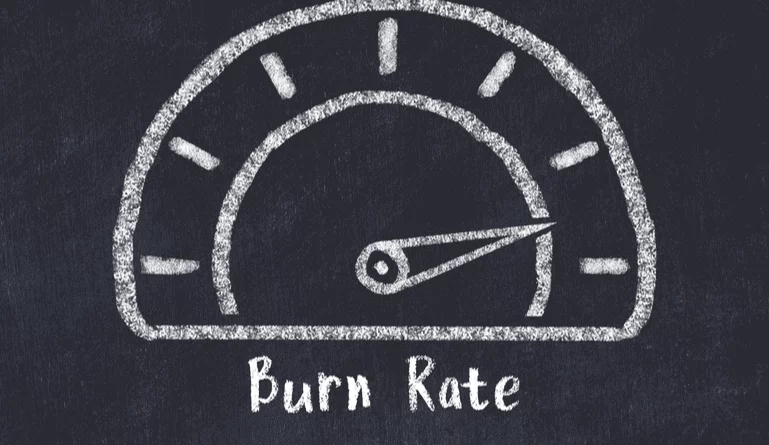Burn rate is an important metric for any business to be aware of to ensure a positive growth rate. Many small business-owners have no idea what burn rate is or how it’s calculated. Accounting software doesn’t calculate burn rate directly for you, but you can calculate it using your financial statements.
What is Burn Rate?
Burn rate refers to the speed at which companies deplete their cash in loss-generating situations. Companies, including startups, use it to measure their performance and valuation.
Early in a startup’s lifecycle, the organization is often focused on expanding its customer base and improving its product rather than generating a positive net income. The burn rate of a company is thus a determining factor for seed-stage investors or venture capitalists.
How Does Burn Rate Work?
The net burn rate is the simplest measure of whether a business is self-sustaining. If positive, it indicates that you are spending more money than you are bringing in. If you want to increase revenue, you need to cut costs.
In addition, you can determine your runway by comparing your burn rate to your total funds. Once it reaches the point of exhaustion, you’ll have to either close the business or find new funding sources. For example, you might acquire a loan, lure venture capital, or opt for an IPO.
It is another factor investors consider. The business plan will be compared to determine if the business is likely to become profitable.
It may be calculated after someone invests in a company to monitor its progress. Investors will want to know why it is getting worse, not better, so they can understand what the company is doing wrong.
Who Should Worry About Burn Rate?
The burn rate is one of the most critical metrics for three types of businesses:
-
Startups backed by venture capital
Venture capitalists are the most common investors in startups. They invest cash in the development and marketing of the company’s products. Often, they will operate at a loss for years before either succeeding (making profits) or running out of funds.
The burn rate of a startup business can help owners determine how long they can operate at a loss before they must turn a profit. The time between when cash reserves are emptied and when they are replenished is referred to as the “cash runway”.
-
New companies gaining traction
Starting a business with no customers can be challenging. Start advertising on social media and launch a killer website for your online apparel store, for example. You will spend money on advertising and web hosting until customers start making purchases, but you will not earn any money from this.
Your burn rate determines how long you need to make a profit and what you should do in the meantime – such as whether you need to invest more in advertising or diversify your inventory.
-
Older companies borrowing money during difficult times
Changing fads and a change in trends can cause even profitable businesses to falter. To keep the lights on while you develop new strategies to start breaking even again, you can use a small business loan or a line of credit.
You’re operating a lot like a new business when making a big change like this. You should know how long you have left before the bank runs out of money to experiment with ways to increase revenue. If you start making a profit again, you should also budget for interest payments.
How to Calculate Burn Rate
You’ll need the balance sheet for the period you’re assessing to calculate it. The steps to calculate are:
- You should look at a recent period to assess burn rate, which is a current metric.
- Check your balance sheet to determine where your cash balance is at the beginning and end of that period.
- Calculate your ending cash balance by subtracting your beginning cash balance.
- Calculate the difference by multiplying it by the number of months you are evaluating.
Even though it is typically calculated every month, you need to consider more than one month’s worth of numbers to get a more accurate calculation.
As a result, you will be able to capture expenses and other cash outlays that do not occur monthly. Furthermore, you’ll be able to ensure your calculations aren’t skewed by bad (or good) sales months.
Comparison of Gross and Net Burn Rates
The function of burn rate is also divided into two types: gross and net.
Rather than taking revenue into account, gross burn measures operating expenses. On the other hand, a net burn rate shows you how much money you spend per month but also includes revenue.
A gross burn rate is important if you’re interested in measuring operating expenses. You can measure profit growth by calculating the net burn rate, which shows how much you’ve made versus how much you’ve spent.
How to Reduce Burn Rate
Here are a few methods:
-
Review your recurring costs
It is your recurring costs that determine your business’ sustainability. In case you’re spending excessivley on a monthly basis on office space, internet, or web hosting, you’ll have a hard time lowering your burn rate.
-
Reduce your owner’s draw
You take an owner’s draw when you pay yourself from your business. Try reducing this outlay if you’re paying yourself with this method; the less you pull out of your capital account each month, the more you will have to work with.
-
Bootstrap your Marketing
If you still aren’t bringing in customers after a few accounting cycles, perhaps you should switch marketing strategies. Utilizing tools such as one-to-one outreach and active social media as part of bootstrap marketing minimizes expenditures.
-
Offer a grand opening sale
Cutting prices may seem counter-intuitive when you are trying to turn a profit as soon as possible. To get your first few sales in, you may have to sell products for less or cut deals for new clients when you’re just starting.
-
Find more funding
Even if operating expenses are the same, larger capital investment or current cash will result in a lower burn rate. Your business might be able to attract investors looking for high-growth opportunities if it is off to a good start but isn’t turning a profit.
Final Thoughts
It isn’t hard to calculate your business’ burn rate. While it can be uncomfortable to deal with if it is high, addressing these metrics before they become an issue is much better than waiting until it is too late.
An unexpected downturn in revenue and cash flow in your business can be caused by a variety of factors, many of which are beyond your control. While things are going well in your business, you can address your burn rate and cash runway proactively to be better prepared to weather any storms.






